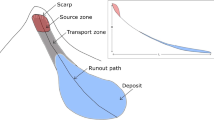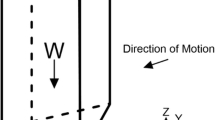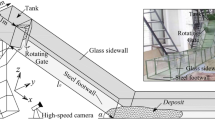Abstract
A Central Asia rock avalanche (rockslide) inventory that includes about 600 case studies with measured parameters is used to present a quantitative characterization of rock avalanche mobility and its dependence on the controlling parameters such as volume and height drop. The mobility can be characterized by runout and angle of reach, as well as by the affected area. The database was analyzed after dividing the rock avalanches into three confinement categories—frontally confined, laterally confined, and unconfined. In addition to the traditionally used slope failure volume and height drop, we correlated mobility parameters with their product that is proportional to the potential energy released during rock avalanche emplacement. It was found that coefficients of determination of the regressions of the affected area with volume and, especially, with its product with maximal height drop are higher than those of volume with runout and much higher than those of volume with angle of reach for all confinement conditions. Thus, these relationships provide an optimal characterization of the rock avalanche mobility. Relative influence of failure volume and height drop on rock avalanche mobility was also analyzed. The regression equations obtained in this study were successfully applied to several case studies from other mountain regions. The proposed regression equations can be used to predict the exposure of elements at risk threatened by anticipated rock avalanches. They can also be used to estimate the parameters of rockslide dams that might originate at the sites with anticipated large-scale rock slope failures, if their volumes and height drops can be assessed. The confinement conditions are statistically proved to influence the rock avalanche mobility and must be taken into consideration during hazard and risk assessment.
















Similar content being viewed by others
References
Abdrakhmatov K, Strom A (2006) Dissected rockslide and rock avalanche deposits; Tien Shan Kyrgyzstan. In: Evans SG, Scarascia Mugnozza G, Strom A, Hermanns RL (eds) Landslides from massive rock slope failure. NATO science series: IV: earth and environmental sciences, 49. Springer, New York, pp 551–572
Abele G (1974) Bergstürze in den Alpen, ihre Verbeitung, Morphologie und Folgeerscheinungen, Wissenschaftliche Alpenverein 25, pp 230
Adushkin VV (2006) Mobility of rock avalanches triggered by underground nuclear explosions. In: Evans SG, Scarascia Mugnozza G, Strom A, Hermanns RL (eds) Landslides from massive rock slope failure. NATO science series: IV: earth and environmental sciences. 49. Springer, New York, pp 267–284
Chen Q, Cheng H, Yang Y, Liu G, Liu L (2014) Quantification of mass wasting volume associated with the giant landslide Daguangbao induced by the 2008 Wenchuan earthquake from persistent scatterer InSAR. Remote Sens Environ 152:125–135
Corominas J (1996) The angle of reach as a mobility index for small and large landslides. Can Geotech J 33:260–271
Corominas J, van Westen C, Frattini P, Cascini L, Malet J-P, Fotopoulou S, Catani F, Van Den Eeckhaut M, Mavrouli O, Agliardi F, Pitilakis K, Winter MG, Pastor M, Ferlisi S, Tofani V, Hervás J, Smith JT (2014) Recommendations for the quantitative analysis of landslide risk. Bull Eng Geol Environ 73:209–263
Corominas J, Einstein H, Davis T, Strom A, Zuccaro G, Nadim F, Verdel T (2015) Glossary of terms on landslide hazard and risk. In: Lollino G et al (eds) Engineering geology for society and territory, vol 2. Springer International Publishing, Switzerland, pp 1775–1779
Crosta GB, Imposimato S, Roddeman DG (2003) Numerical modeling of large landslides stability and runout. Nat Hazards Earth Syst Sci 3:523–538
Crosta GB, Frattini P, Valbuzzi E, Hermanns RL (2015) The Cerrillos Negros Giant rock avalanches (Tacna, Peru). In: Lollino G, Giordan D, Crosta GB, Corominas J, Azzam R, Wasowski J, Sciarra N (eds) Engineering geology for society and territory, vol 2. Springer International Publishing, Switzerland, pp 921–924
Davies TR (1982) Spreading of rock avalanche debris by mechanical fluidization. Rock Mech 15:9–24
Davies TR, McSaveney MJ, Reznichenko N (2017) The fate of elastic strain energy in brittle fracture. In: Leith K, Ziegler M, Perras M, Loew S (eds) Progressive rock failure. An ISRM specialized conference, Monte Verità, 5–9 June 2017. ETH, extended abstracts, pp 107–108
Denlinger RP, Iverson RM (2001) Flow of variably fluidized granular masses across three-dimensional terrain: 2. Numerical predictions and experimental tests. J Geophys Res 106B:553–566
Dubovskoi AN, Pernik LM, Strom AL (2008) Experimental simulation of rockslide fragmentation. J Min Sci 44(2):123–130
Dufresne A, Prager C, Bösmeier AS (2016) Insights into rock avalanche emplacement processes by detailed morpho-lithological studies of the Tschirgant deposit (Tyrol Autria). Earth Surf Process Landf 41(5):587–602
Eisbacher GH, Clague JJ (1984) Destructive mass movements in high mountains: hazard and management. Geol Surv Can Pap:84–16
Evans SG, Delaney KB (2011) Characterization of the 2000 Yigong Zangbo River (Tibet) landslide dam and impoundment by remote sensing. In: Evans SG, Hermanns R, Scarascia-Mugnozza G, Strom AL (Eds) Natural and artificial rockslide dams, 133. Lecture Notes in Earth Sciences, pp 543–559
Evans SG, Roberts NJ, Ischuck A, Delaney KB, Morozova GS, Tutubalina O (2009) Landslides triggered by the 1949 Khait earthquake, Tajikistan, and associated loss of life. Eng Geol 109(3–4):195–212
Fan J-R, Zhang X-Y, Su F-H, Ge Y-G, Tarolli P, Yang Z-I, Zeng C, Zeng Z (2017) Geometrical feature analysis and disaster assessment of the Xinmo landslide based on remote sensing data. J Mt Sci 14(9):1677–1688
Geological disaster InSAR technology research center (2018) http://www.vastitude.com.cn/newsinfo/586480.html. (in Chinese)
Grigorian SS (1979) New friction law and mechanism of large-scale rockfalls and landslides, proceedings of Academy of Sciences of USSR, vol 244, pp 846–849 (in Russian)
Griswold JP, Iverson RM (2008) Mobility statistics and automated hazard mapping for debris flows and rock avalanches (ver. 1.1, April 2014): U.S. Geological Survey Scientific Investigations Report 2007–5276, pp 1–59
Heim A (1932) Bergsturz und Menschenleben. Fretz and Wasmuth, Zurich
Heuberger H, Masch L, Preuss E, Schreker A (1984) Quaternary landslides and rock fusion in Central Nepal and the Tyrolean Alps. Mt Res Dev 4:345–362
Hewitt K (1998) Catastrophic landslides and their effects on the upper Indus streams, Karakoram Himalaya, Northern Pakistan. Geomorphology 26:47–80
Howard K (1973) Avalanche mode of motion: implications from lunar examples. Science, New Series 180:1052–1055
Hsü KJ (1975) Catastrophic debris streams (sturzstroms) generated by rock falls. Geol Soc Am Bull 86:129–140
Huang R, Pei X, Zhang W (2009) Further examination on characteristics and formation mechanism of Daguangbao landslide. J Eng Geol 6:725–736
Huang R, Pei X, Fan X, Zhang W, Li S, Li B (2012) The characteristics and failure mechanism of the largest landslide triggered by the Wenchuan earthquake, May 12, 2008. China. Landslides 9:131–142
Hungr O (1995) A model for the runout analysis of rapid flow slides, debris flows, and avalanches. Can Geotech J 32:610–623
Hungr O (2006) Rock avalanche occurrence, process and modelling. In: Evans SG, Scarascia Mugnozza G, Strom A, Hermanns RL (eds) Landslides from massive rock slope failure. NATO science series: IV: earth and environmental sciences, 49. Springer, New York, pp 243–266
Hungr O, McDougall S (2009) Two numerical models for landslide dynamic analysis. Comput Geosci 35:978–992. https://doi.org/10.1016/j.cageo.2007.12.003
Hungr O, Leroueil S, Picarelli L (2014) Varnes classification of landslide types, an update. Landslides 11:167–194
Iverson RM (2006) Forecasting runout of rock and debris avalanches. In: Evans SG, Scarascia Mugnozza G, Strom A, Hermanns RL (eds) Landslides from massive rock slope failure. NATO science series: IV: earth and environmental sciences, 49. Springer, New York, pp 197–209
Iverson RM, Denlinger RP (2001) Flow of variably fluidized granular masses across threedimensional terrain: 1. Coulomb mixture theory. J Geophys Res 106B:537–552
Kilburn CRJ, Sørensen S-A (1998) Runout length of sturzstroms: the control of initial conditions and of fragment dynamics. J Geophys Res 103B:17877–17884
Kobayashi Y (1993) A hypothesis for reduced resistance in large landslides, in Safety and Environmental Issues in Rock Engineering. Proc. of the ISRM Int. Symp. Lisboa, June 21–24, 1993 I. Balkema Rotterdam, pp 335–339
Kobayashi Y (1997) Long runout landslides riding on basal guided wave. In: Marinos K, Tsiambaos S (eds) Engineering geology and the environment. Balkema, Rotterdam, pp 761–766
Legros F (2002) The mobility of long-runout landslides. Eng Geol 63:301–331
Legros F (2006) Landslide mobility and the role of water. In: Evans SG, Scarascia Mugnozza G, Strom A, Hermanns RL (eds) Landslides from massive rock slope failure. NATO science series: IV: earth and environmental sciences, 49. Springer, New York, pp 233–242
Li T (1983) A mathematical model for predicting the extent of a major rockfall. Z Geomorphol 27:473–482
McDougall S, Hungr O (2004) A model for the analysis of rapid landslide motion across three - dimensional terrain. Can Geotech J 41(6):1084–1097. https://doi.org/10.1139/T04-052
Melosh HJ (1986) The physics of very large landslides. Acta Mech 64:89–99
Nadim F, Kjekstad O, Peduzzi P, Herold C, Jaedicke C (2006) Global landslide and avalanche hotspots. Landslides 3:159–173
Nicoletti PG, Sorriso-Valvo M (1991) Geomorphic controls of the shape and mobilily of rock avalanches. Geol Soc Am Bull 103:1365–1373
Ouyang C-J, Zhao W, He S-M, Wang D-P, Zhou S, An H-C, Wang Z-W, Cheng D-X (2017) Numerical modeling and dynamic analysis of the 2017 Xinmo landslide in Maoxian County, China. J Mt Sci 14:1701–1711
Pollet N, Cojean R, Couture R, Schneider J-L, Strom AL, Voirin C, Wassmer P (2005) A slab-on-slab model for the Flims rockslide (Swiss Alps). Can Geotech J 42:587–600
Pudasaini SP, Jaboyedov M (In press) A general analytical model for superelevation. Paper submitted to Landslides
Reznichenko NV, Andrews GR, Geater RE, Strom A (2017) Origin of large hummock deposits “chukuryi” in Alai Valley, Northern Pamir: geomorphological and sedimentological investigation. Geomorphology 285:347–362
Sassa K, Fukuoka H, Lee J-H, Shoaei Z, Zhang D, Xie Z et al (1994) Prediction of landslide motion based on the measurement of geotechnical parameters. In: Development of a new cyclic loading ring shear apparatus to study earthquake-induced landslides. Report for Grant-in-Aid for Developmental Scientific Research by the Ministry of Education, Science and Culture, Japan (Project No 03556021), DPRI, Kyoto. pp 72–106
Sassa K, Nagai O, Solidum R, Yamazaki Y, Ohta H (2010) An integrated model simulating the initiation and motion of earthquake and rain induced rapid landslides and its application to the 2006 Leyte landslide. Landslides 7:219–236
Shakirov R, Shilina E, Strom A, Zhirkevich A (2018) Slopes stability in the catchment areas and effect of large-scale rockslide damming on hydraulic projects safety by example of catchment areas of Vakhsh and Siang rivers. Proceedings of 26th ICOLD World Congress. Symposium Hydro Engineering, July 2–3, 2018, Vienna, Austria, pp 2603-2614. https://doi.org/10.3217/978-3-85125-620-8-232
Shaller PJ (1991) Analysis and implications of large Martian and terrestrial landslides, Ph.D. Thesis. California Institute of Technology
Sheidegger AE (1973) On the prediction of the reach and velocity of catastrophic landslides. Rock Mech 5:231–236
Strom AL (2006) Morphology and internal structure of rockslides and rock avalanches: grounds and constraints for their modelling. In: Evans SG, Scarascia Mugnozza G, Strom A, Hermanns RL (eds) Landslides from massive rock slope failure. NATO science series: IV: earth and environmental sciences 49, pp 305–328
Strom A (2018) Large-scale rockslide inventory of the Central Asia region: data and analysis. In: Shakoor A and Cato K (eds) IAEG/AEG annual meeting proceedings, San Francisco, California, 2018, 1 pp 145–153. https://doi.org/10.1007/978-3-319-93124-l_18
Strom A, Abdrakhmatov K (2018) Rockslides and rock avalanches of Central Asia: distribution, morphology, and internal structure. Elsevier. ISBN: 978-0-12-803204-6
Strom A, Pernik L (2013) Modeling of debris crushing during rock avalanche motion. Geophys Res Abst 15, EGU2013 p 1373
von Poschinger A, Wassmer P, Maisch M (2006) The Flims rockslide: history of interpretation and new insights. In: Evans SG, Scarascia Mugnozza G, Strom A, Hermanns RL (eds) Landslides from massive rock slope failure. NATO science series: IV: earth and environmental sciences, vol 49. Springer, Heidelberg, pp 329–356
Zhang Z, He S, Liu W, Liang H, Yan S, Deng Y, Bai X, Chen Z (2019) Source characteristics and dynamics of the October 2018 Baige landslide revealed by broadband seismograms. Landslides 16:777–785. https://doi.org/10.1007/s10346-019-01145-3
Acknowledgements
Authors want to thank the anonymous reviewers for useful and meaningful comments.
Funding
This study was supported by the National Natural Science Foundation of China (Grants No 41525010 and 41807291) and the 111 Plan—Program of Introducing Talents of Discipline to Universities of the Ministry of Education and of State Administration of Foreign Experts Affairs of the People’s Republic of China, and is a part of the project “Central Asia rockslide inventory: compilation and analysis,” recognized by the International Consortium on Landslides and International Program on Landslides as World Centre of Excellence for the period of 2017–2020.
Author information
Authors and Affiliations
Corresponding author
Rights and permissions
About this article
Cite this article
Strom, A., Li, L. & Lan, H. Rock avalanche mobility: optimal characterization and the effects of confinement. Landslides 16, 1437–1452 (2019). https://doi.org/10.1007/s10346-019-01181-z
Received:
Accepted:
Published:
Issue Date:
DOI: https://doi.org/10.1007/s10346-019-01181-z




